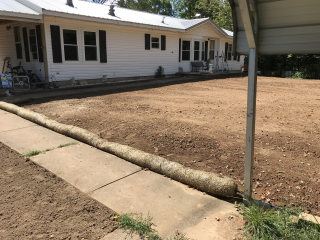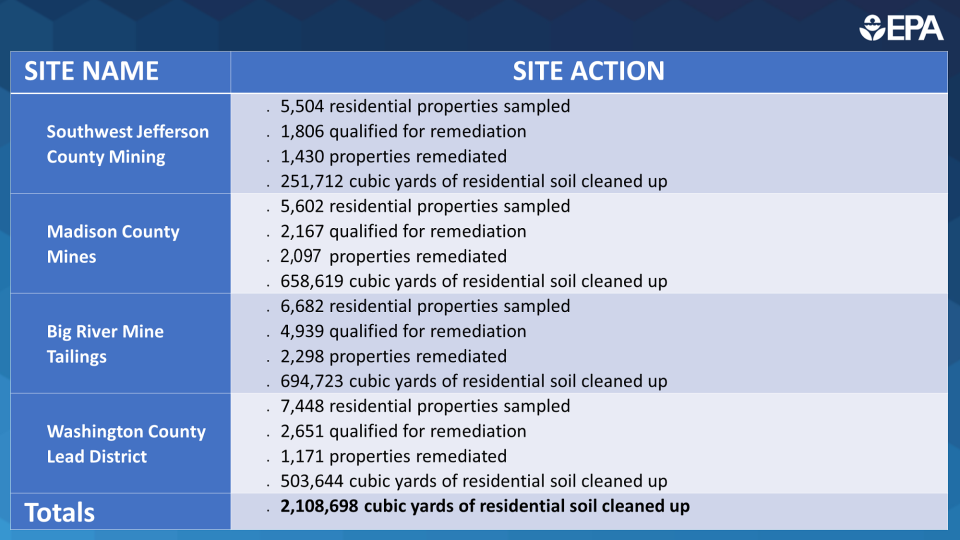Residential Yards Remediated in Region 7: An Overview of Lead Cleanup Activities in Southeast Missouri
– EPA Region 7 Feature –
By Rachael Puleo, Superfund and Emergency Management Division
EPA Region 7 has made significant strides in remediating contaminated areas in southeastern Missouri to help revitalize the environment and protect human health from the effects of lead-contaminated waste from historical mining.
Lead in Our History
As a global leader in heavy metal ore production for most of the late 19th and early 20th centuries, Southeast Missouri (SEMO) held some of the world’s largest known lead deposits in a region, referred to as the Old Lead Belt. Lead ore deposits were first discovered there by French explorers at the end of the 16th century. Mining for lead and other associated metals began in 1720 and is still being done today.
Over time, the uses of lead have evolved from a preservative in wine during the Roman Empire to an additive in paint and gasoline in the 1900s. Today, about 90% of lead is used in batteries, primarily for automobiles.
Lead's resistance to corrosion greatly enhances its strength and durability, making it a sought-after material and one of the first metals known to humans. Ore deposits in the region occur mostly in the Bonne Terre Formation, which is composed primarily of dolomite – a sedimentary carbonate rock. Early mining operations were diggings (hand-excavated pits or shafts) to extract residual minerals from shallow soil typically less than 20 feet deep. Shafts were dug to the bedrock, where ores are commonly concentrated, and material was brought to the surface using picks, shovels and buckets.
As time went on, mining and excavation techniques advanced, allowing for much larger quantities of ore to be brought to the surface and refined. The U.S. Geological Survey estimates that over 8.5 million tons of pure lead have been produced in the Old Lead Belt. Raw materials in large quantities have been excavated, brought to the surface, milled, refined, and smelted into nearly pure metal products.
However, the extensive mining activities across five counties in SEMO produced significant amounts of waste by-products containing toxic metal residues, resulting in widespread contamination of local soil, groundwater, surface water, and sediments. The leftover slurries from milling, known as tailings, were typically pumped into tailing ponds for disposal, while fragments of host rock separated from the ores were thrown beside the conveyor belts to create chat piles.
Lead Still Remains
As communities were built around mining operations, lead poisoning became a more serious concern. To date, EPA Region 7 has designated seven Superfund sites in SEMO where lead and other related metals have been identified at levels that pose unacceptable risk to human health and the environment. (See SEMO map above.) Those sites were placed on EPA’s National Priorities List (NPL) between 1992 and 2017, and include: Southwest Jefferson County Mining, Madison County Mines, Big River Mine Tailings, and four sites within Washington County Lead District (Furnace Creek, Old Mines, Potosi, and Richwoods).
EPA has also undertaken early cleanup actions at two other sites in the area that are not currently on the NPL, which are the Annapolis Lead Mine Superfund Site in Iron County and the Viburnum Trend Lead Haul Roads Superfund Site in and around Viburnum, Missouri.
Lead Cleanup Efforts
So far, Region 7 has cleaned up nearly 8,500 residential properties in SEMO. This totals just over 2 million cubic yards of residential soil, which is the size of almost 100 football fields filled to the height of a goal post (10 feet high!). Residential properties are defined as residential yards, public use areas, and child high-use areas (such as child care facilities, public parks, playgrounds, and other public recreational areas).
If soil sampling results indicate a property is eligible for remediation based on the Record of Decision (ROD) for that site, the property owner can request to have their yard remediated free of charge by signing a remedial access agreement. The cleanups include excavation of contaminated soil, gravel, or other yard elements that exceed EPA’s residential lead cleanup levels as defined in the ROD. The excavated material is transported off property to a repository, where it is consolidated and maintained in a controlled disposal facility to prevent future release and redistribution of the contamination. EPA then replaces the yard with clean soil or gravel (backfill) and revegetates the yard with sod and hydroseed to restore it as closely as possible to its original condition (grade and contour).
In affected areas, EPA also provides free testing of residential wells to detect heavy metal contamination in groundwater from historical mining activities. Both groundwater and soil remediation are essential to identifying elevated blood lead levels in vulnerable populations such as children. EPA offers free well water and soil testing, conducted by experienced contractors, to residential property owners within Superfund site boundaries. For residents whose residential drinking water wells are identified to have high levels of metal contamination, EPA may provide an alternative supply of water. This response action is temporary to prevent further exposure until a remedial action to address the contamination has been identified and completed.
Commitment to Continued Cleanup
EPA is committed to residential yard cleanup work, as it is essential in promoting the reduction of children's exposure to lead. As understanding of lead’s impact on human health has increased, the Centers for Disease Control and Prevention (CDC) now recognizes there to be no safe blood lead level in children.
A 2019 EPA study of two decades of children’s blood lead levels (BLLs) in six states indicated that Superfund cleanups lowered the risk of elevated BLLs for children living within 1.24 miles of lead-contaminated sites by 8 to 18%. Children under the age of 7 should be tested for lead poisoning annually, as lead-poisoned children do not always look or act sick. EPA encourages parents and caregivers to work with family pediatricians and local county health departments to detect this toxicity through blood lead level testing.
Work will continue at these Superfund sites to also sample and remediate parks, gardens, and children’s playgrounds to ensure that common use areas are safe for communities to enjoy without the risk of exposure to lead. EPA’s activities also extend to the sampling, evaluation, and cleanup of remaining sources of contamination in the communities – mine waste piles, abandoned rail lines, contaminated soils, floodplain soils, and stream, river and lake sediments that pose risk to human health and the environment. EPA Region 7 has made great steps in removing lead from Southeast Missouri and continues to help clean up and restore yards, while engaging communities in health education and safe practices to reduce exposure to lead.
- Learn more about protecting your family from lead contamination.



